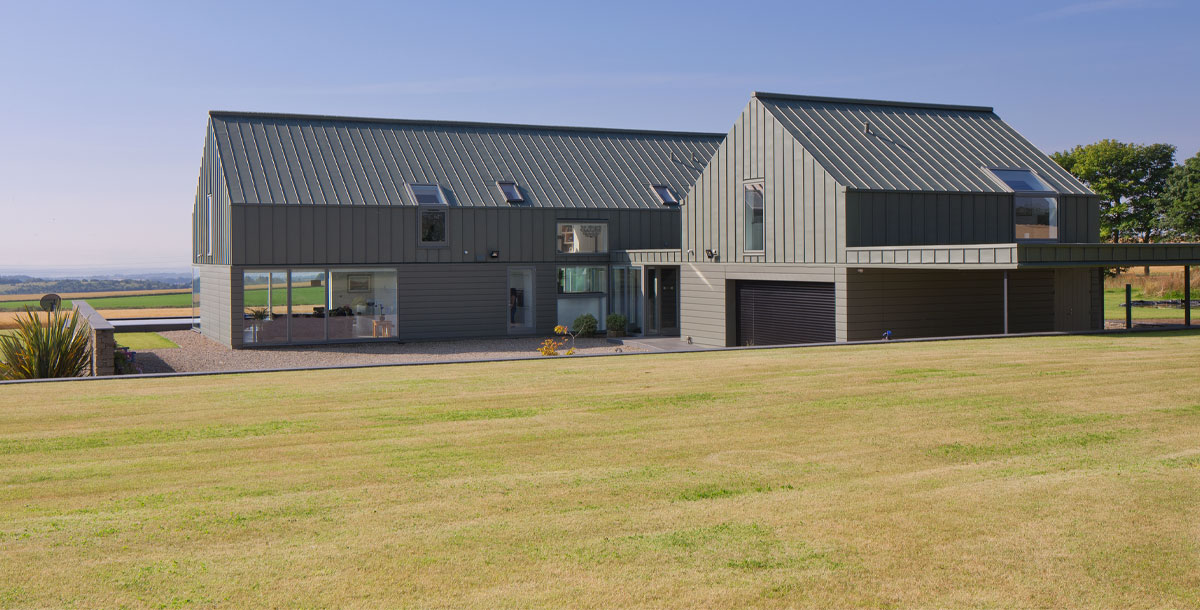Rugged countryside inspires zinc-clad home
Imposing yet subtle, Richard and Jackie Callison's home takes its design cues from its surrounds
Despite sitting proud of the brow of a hill, the Grand Designs Zinc House in Angus successfully merges into the rolling rural landscape. Indeed so quietly and unobtrusively has this remarkable new villa settled into the Angus countryside, the President of the RIAS (Royal Incorporation of Architects in Scotland), a local resident, had driven past a number of times while taking his son to Scouts – without even noticing it.
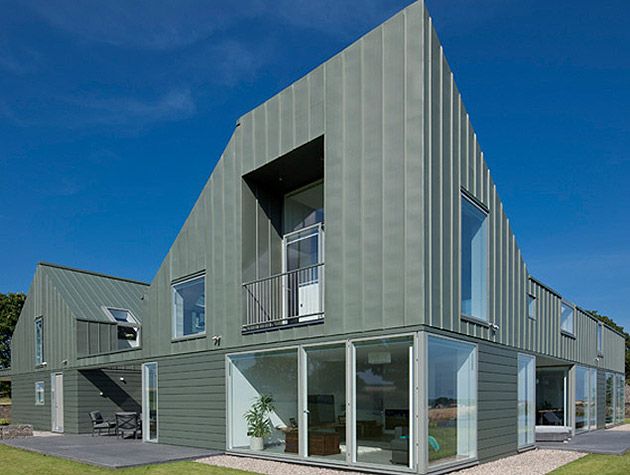
Photo: David Barbour
‘A language for houses in the Scottish landscape’
The penny dropped when he was visiting the house while judging for the Best Building in Scotland Awards. It’s a story that architect Graeme Hutton recounts with some satisfaction. ‘We’re not about one-off fancy villas,’ says Hutton, Professor of Architecture at the University of Dundee, who designed Zinc House in conjunction with LJRH Architects. ‘We are interested in creating a language for houses in the Scottish landscape, the results of which might be quiet and modest.
It’s not about making statements.’ The distinctive hue of Zinc House takes its cue specifically from the Angus landscape. ‘Remnants of greeny-grey chlorite infuse the rocks of the drystone dykes that form the gridded field patterns of the landscape,’ says Hutton. ‘This informed the decision to clad the building in a single skin of grey-green zinc; when we first put the zinc sample next to the wet stone on the site, the colour matched.’
It was a eureka moment. ‘The house now blends in so well with the landscape, that on a cloudy day it looks battleship grey, yet in the late sun it’s almost green,’ continues Hutton. ‘When rain falls on the sandstone in the courtyard, the building and its surrounding walls are almost the same colour.’
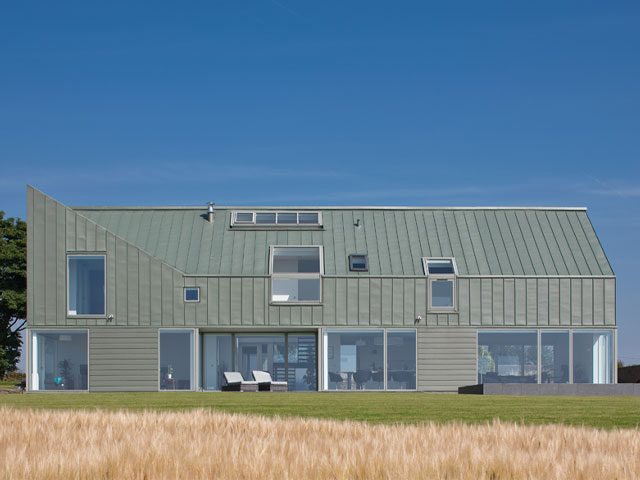
Photo: David Barbour
Reflecting the landscape
The form of Zinc House also reflects the landscape, echoing the agricultural sheds that previously stood on the site, and that owners Richard and Jackie Callison bought in 2005 along with the neighbouring farmhouse and agricultural land. The couple, who had lived in a converted cottage next to the farm for almost 30 years, had always coveted the view from the sheds.
‘The farmhouse and sheds were on the brow of the hill and had a lovely aspect, so I’d always had my eye on it. When the farmer offered the plot for sale we put in a bid, which was successful,’ explains Richard. ‘At the time, the local authority’s neighbourhood plan wouldn’t allow any new building where the sheds were positioned. But an updated local plan was introduced around 2010 that permitted building on a brownfield site. The disused farm buildings were classed as brown field, so this paved the way for us to think about building a new house.’
The couple’s initial idea was to build a German kit house on the site, but this changed when they came across Drummond Shed, a zinc-clad family home in rural Perthshire, designed by Graeme Hutton and LJRH. ‘We spoke about capitalising on the lovely aspect,’ says Richard. ‘We spent a lot of time on the site looking at views and working out where we wanted the main spaces to go. We also wanted an open-plan design for the main living areas. Having come from a traditional cottage with small rooms and passageways, we were keen to create lots of large airy spaces with no corridors.’
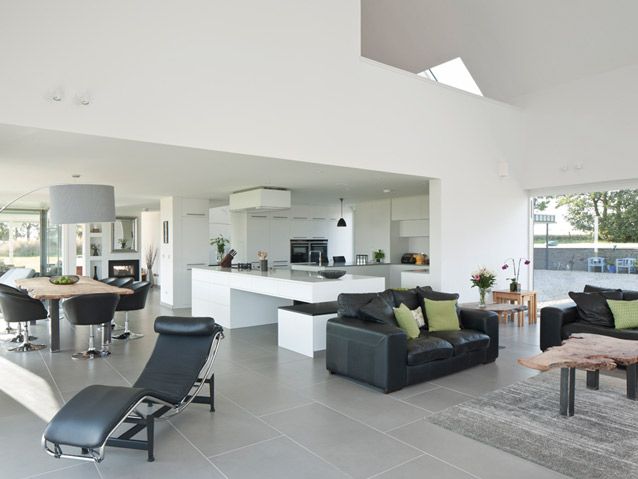
Photo: David Barbour
White and minimalist
Planners were extremely receptive to Hutton’s design that, when viewed from the east and west elevations, appears to be two houses in one, linked by a central glazed single-storey entrance. A smaller wing to the north features a carport leading to a storeroom and utilities on ground level, with the couple’s office and studio space above.
An adjoining larger wing contains all the open-plan living spaces arranged along the south elevation at ground level, with the kitchen at its heart. Located above are three bedrooms (in addition to a ground-level guest bedroom) and a study area. The whole house is unified by a continuous zinc roof stretching all the way over the two-storey living accommodation, down to the single-storey connecting entrance, up again to the two-storey working block, then dipping down again to form the carport roof.
The undulations reflect the surrounding rolling landscape. Externally, sheltered terraces face south and west with a further outdoor space – the entrance courtyard – providing privacy to the north-facing living areas. Internally, Richard and Jackie were aiming for simplicity. ‘We wanted it white and minimalist,’ says Richard.
‘Initially we were going to have oak doors throughout the whole of the ground-floor, but we thought that even this would detract from the clean look that we were after, so we chose Italian tiles instead that reflect the green tinge of the zinc cladding.’ The strategically placed aluminium Velfac windows, which are timber inside, have been powder-coated to a similar zinc-like hue that adds a seamlessness to the external design.
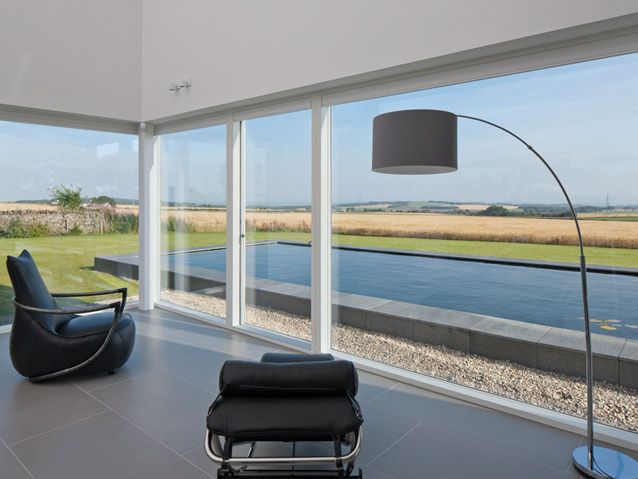
Photo: David Barbour
Passive with an ‘e’
The Callisons kept a close eye on the project from their cottage nearby, as the build took shape over the best part of two years. The hybrid steel and timber frame building emerged as a house that’s ‘passive with an “e”,’ says Hutton. ‘We didn’t try to achieve Passivhaus accreditation, but it is passive in that it’s a narrow plan, naturally ventilated with the voids allowing air to move.
‘Due to the amount of glazing, we have a lot of insulation elsewhere in the building to compensate. A bank of photovoltaic panels to the west of the house supplements the underfloor heating; we looked at a ground source heat pump, but I don’t think in this case it would have been terribly economical,’ says Hutton. ‘It’s a practical approach to the environmental performance of the house.’
The Callisons are clearly thrilled with the results. ‘It’s not a carbon neutral or airtight house, but it works for us. It can be hot in summer with the solar gain, but there are plenty of windows to get a through draught. And the windows are one of the main reasons that we still pinch ourselves every time we come home,’ concludes Richard.
‘The long views through the house to the landscape beyond are always changing with the seasons and the weather. There is great scenery all around the house; from the bath and from the master bedroom we can look over to St Andrews and the sea beyond, and there are panoramic vistas from the south-facing living spaces. You could just spend your time looking out, and I often do!’
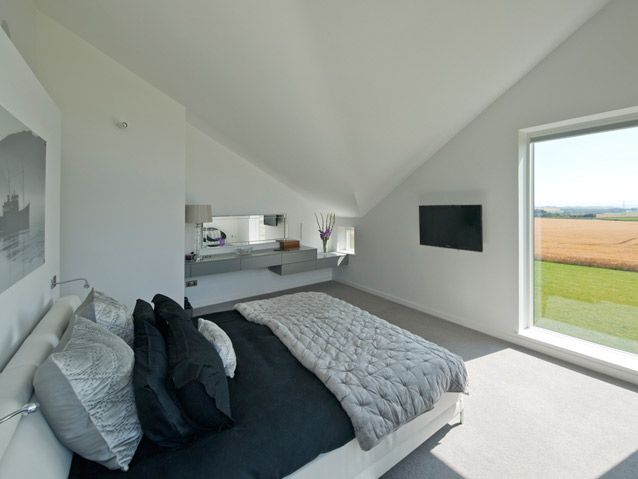
Photo: David Barbour
Grand Designs Zinc House project notes
Who Richard and Jackie Callison
Where Angus, Scotland
Property Timber- and steel-framed house with zinc cladding
Bedrooms 4 Bathrooms 3
Project started: January 2013
Project finished: June 2015
Build cost £850,000
Size of house: 525sqm

